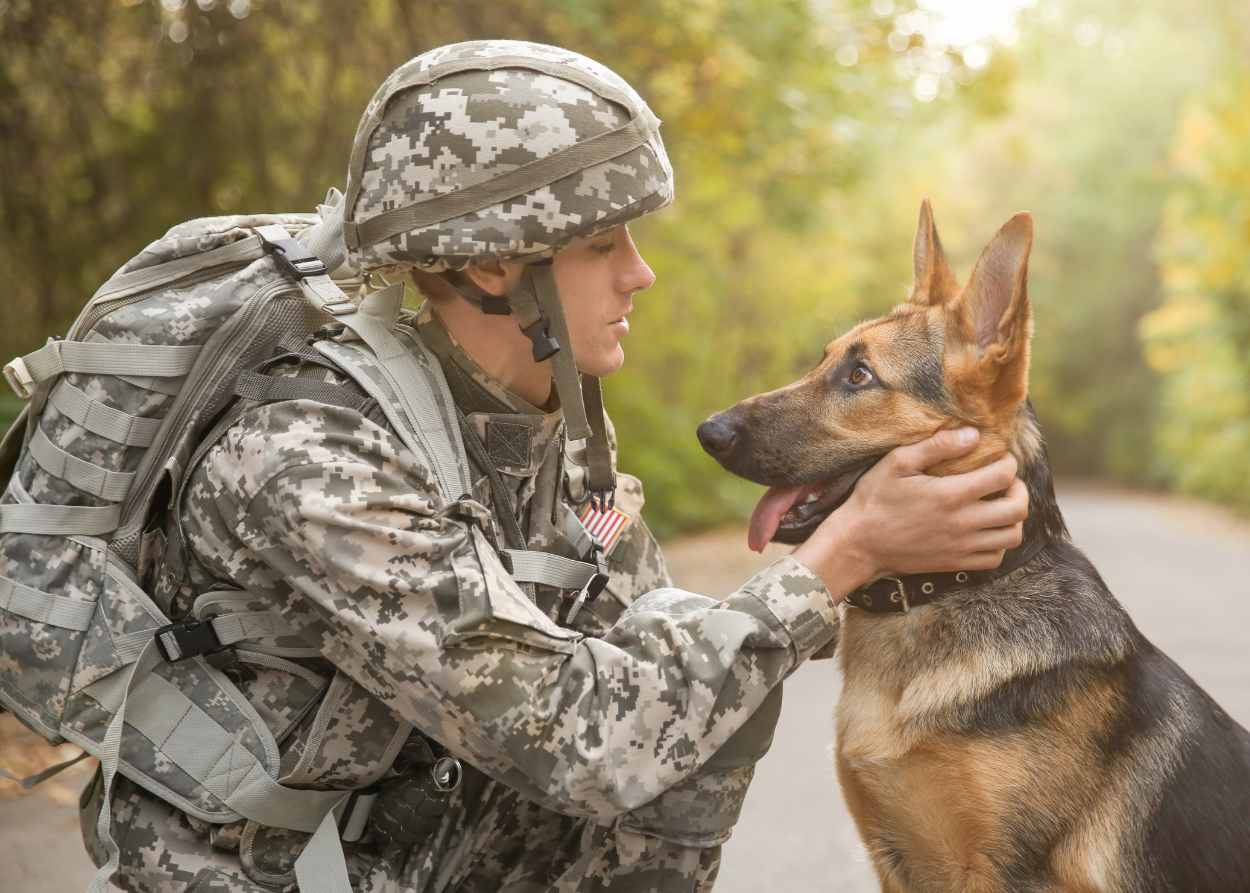April 11 is Dog Therapy Appreciation Day, a day to show our gratitude toward dogs that bring comfort amidst challenges in our daily lives. From reducing stress and anxiety to improving mood and overall well-being, the presence of therapy dogs enhances patient outcomes, accelerates recovery, and fosters a sense of community and belonging. Through their unconditional love and unwavering support, these furry facilitators bridge the gap between worlds, bringing joy, comfort, and healing to those in need.
Explore how therapy dogs are compassionate canines that uplift spirits, make connections, and ignite hope in hospitals, schools, nursing homes, disasters, and more as we celebrate Dog Therapy Appreciation Day.
Spring on the Yellow River, 13th Century Chinese Scroll with Seeing Eye Dog
Utilizing Animals as Therapy Throughout the Centuries
For centuries, humans have utilized the bond between animals and humans to harness the healing power of pets. The Ancient Greeks used horses to lift the spirits of people in poor health. A 13th-century scroll from China depicts a dog leading a blind man. In Medieval times, Belgium rehabilitated both pets alongside human healing as part of natural therapy. Later in Germany, animals’ healing powers were applied as one form of treatment in mental illness facilities. Even modern nursing’s founder Florence Nightingale understood the healing power of pets when she said in 1860 that “a small pet is often an excellent companion for the sick, for long chronic cases especially.”
German Dr. Gerhard Stalling thought blind soldiers returning from World War I would benefit from guide dogs. Joining forces with the German Red Cross Ambulance Dogs Association, Dr. Stalling opened the first seeing-eye dog school in Oldenburg to train guide dogs using a systematic approach to uphold the same standards of all dogs graduating into service. Later, the first seeing-eye dog in America was named Buddy, impressing New Yorkers in 1928 with his ability to help his handler navigate a busy street.
Who's a good boi?
— GW Cancer Center (@GWCancer) March 15, 2024
Faroe, the GW Cancer Center's therapy dog, is! Patients in the infusion center ❤️ him, and his visits make their day that much better! #therapydogs #GWcancerCenter #mustlovedogs pic.twitter.com/VvjxrC3DgC
Modern Animal-Assisted Therapy
The 20th century saw the dawn of modern research and official use of animals in therapy settings. Even though medical professionals have known all along about the benefits of animals to a person’s well-being, the official field of Animal-Assisted Therapy (AAT) did not gain traction until scientists studied and published findings in the mid-1900s. The purpose of Animal-Assisted Therapy is to achieve therapeutic goals through a “facilitated interaction between patients and trained animals (as therapists) accompanied by human owners or handlers.” AAT works in conjunction with traditional medicine for all sorts of conditions with an alternative approach to treatment, offering proven and promising results.
Scientists credited with being the founders of AAT are Psychologist Dr. Boris Levinson and Konrad Lorenz, an Austrian Nobel Laureate in Physiology. They explored a phenomenon called the Human-Animal Bond developed by Freud, a relationship between people and animals influenced by mutually beneficial social, physical, and mental behaviors. Through his groundbreaking work, Levinson and Lorenz demonstrated how interactions with animals can alleviate anxiety, promote social connection, and enhance overall well-being. Their research laid the foundation for the integration of animal-assisted therapy into clinical practice.
Which Dog Breeds and Qualities Make Great Service Dogs?
The first hybrid breed mix to create the perfect therapy dog came about in the late 1980s and early 1990s when Labrador Retrievers and Poodles were bred together to create a lineage of hypoallergenic, friendly, and highly trainable therapy dogs they called Labradoodles. Various Doodle mixes, Golden Retrievers, Labrador Retrievers, Poodles, German Shepherds, Belgian Malinois, and other breeds (yes, even small breeds) can serve as therapy dogs in various capacities.
Qualities all service and therapy dogs share
Even though they may vary in breed, size, and therapy purpose, all service and therapy dogs share a similar set of characteristics to be successful in their jobs. They should be:
- Calm
- Gentle
- Patient
- Friendly
- Focused
- Resilient
- Versatile
- Obedient
- Adaptable
- Trustworthy
- Dependable
- Non-aggressive
What type of training is required for therapy dogs?
Training for therapy dogs varies depending on their specific roles and environments typically includes obedience training, socialization with people and other animals, exposure to various environments and stimuli, and specific skills relevant to their roles, such as remaining calm in stressful situations or providing support during reading sessions. Additionally, therapy dogs must undergo regular health screenings and assessments to ensure they are fit for their duties and comply with all legal and ethical requirements. Some are required to adhere to governmental or organizational contracts or keep up with their certifications each year.
Who Benefits From a Therapy Dog’s Services?
Today, pet therapy is not limited to one field in academia. It takes a partnership among many disciplines and organizations, including healthcare, psychology, veterinary medicine, psychiatry, sociology, non-profits, and the pet food industry. People must qualify to receive a therapy dog through various organizations, pledging to train and care for it during its lifetime as the dog provides years of assistance.
Here are several different settings, conditions, and assistance therapy dogs serve.
People living with psychiatric or developmental needs
Therapy dogs provide companionship and unconditional love, serving as a source of comfort and motivation for individuals struggling with depression and other mental illness challenges. Psychiatric service dogs (PSDs) are highly trained to respond to impending mental health crises, provide comfort during episodes or events, interrupt potentially harmful acts, and give a sense of security. The Americans with Disabilities Act (ADA) states individuals with a diagnosed disability that impedes daily life and can care for a dog meet the ADA psychiatric service dog eligibility. Other people who benefit from PSDs are:
- Anxiety disorders: Therapy dogs provide calming companionship and emotional support, helping to alleviate symptoms of anxiety and panic disorders.
- People with Autism Spectrum Disorder: Therapy dogs offer nonjudgmental interaction and sensory stimulation, aiding in social skills development and emotional regulation.
- Individuals with Developmental Disabilities: Therapy dogs support individuals with developmental disabilities by providing unconditional love, companionship, social cues, and opportunities for skill-building and independence.
- Veterans with PTSD: Therapy dogs assist veterans in managing symptoms of post-traumatic stress disorder, offering comfort and companionship during times of distress.
Students with learning disabilities or practicing skills
Therapy dogs assist students with learning disabilities by reducing stress and anxiety, enhancing focus and concentration, lowering high blood pressure, and promoting a positive learning environment. Special programs will bring dogs to allow children of all abilities to practice their literary skills, and dogs listen attentively. For example, therapy dogs represent the program Share a Book: Where Fur Meets Fiction located in Marin County, CA. The program follows current scientific findings from UC Davis that show kids who read to dogs have a 30% improvement in reading fluency.
People in circumstances beyond their control
No matter our best-laid plans, the universe will deliver unexpected obstacles we must navigate. However, we don’t have to do it alone. Therapy comfort dogs, sometimes called facility dogs, lend a compassionate ear (and paw) to those in need, whether they are lonely, sick, surviving trauma due to a relationship or a tragic event, and more. Comfort therapy dogs may be present in these situations:
- Individuals with chronic illnesses: Therapy dogs offer emotional support and companionship to individuals with chronic illnesses, providing comfort and motivation throughout their healthcare journey. Some hospitals employ facility dogs to be on-call for patients who need a cuddle and a snuggle.
- Patients undergoing medical treatments: Therapy dogs offer distraction and comfort to patients undergoing medical procedures or experiencing chronic pain, enhancing overall coping mechanisms and pain management.
- Nursing home residents: Therapy dogs promote emotional well-being and social engagement among seniors, reducing feelings of loneliness and isolation.
- Traumatic events: Devastating high-stress events can upend someone’s entire life in an instant. Whether after a natural disaster or a mass shooting, a dog’s unwavering support and presence can make a huge difference in how a person processes and copes. Comfort therapy dogs help people express emotions unpack the event they just went through, and assist them on their healing journey.
- Abuse survivors: Therapy dogs offer a safe and comforting presence to survivors of trauma or abuse, helping to rebuild trust and confidence in interpersonal relationships. A comfort therapy dog will listen without judgment and provide the unconditional love the victims deserve.
How Does a Therapy Dog Utilize its 5 Senses?
A therapy dog uses its five senses in several ways to assist people in need. A medical assistance dog employs its sense of smell detecting changes in body chemistry that could indicate cancer or an impending seizure. They can actually smell stress as a chemical change in the body from elevated cortisol levels.
A therapy dog can also use its sense of touch when learning to nudge or alert its handler to something amiss, retrieve objects, turn off lights, and assist in other activities of daily living. Deep-pressure therapy dogs can use their body weight to lean on people, calming the nervous system, reducing anxiety, and more.
Therapy dogs can also use their excellent sense of hearing to listen for beeps and medical equipment alarms. Their acute hearing abilities allow them to detect subtle cues, offering comfort and peace to their handler with every attentive head tilt and paw offering, giving silent support that speaks volumes in times of distress.
And of course, we’re all familiar with the noble work that seeing eye dogs for the blind conduct to help their handler navigate life. They detect curbs and changes in elevations, avoid objects hindering movement, and discern when it is safe to proceed.
Be Comforted By a Pawrade Puppy
Most of our Pawrade Team members are dog owners, and we know how beneficial having dogs in our lives can be for our mental and physical well-being. We believe every puppy deserves a loving home, and that’s where we can help each other. All you’ll need to do is choose a future therapy dog among our puppies for sale. You won’t have to worry about finding trustworthy breeders because we’ve already done that for you through our rigorous vetting process. You can put any fears aside of being scammed thanks to our secure pet adoption process. While you’re selecting your comfort companion, we’ll be here every step of the way to assist you in picking out your dream puppy. We can’t wait to hear from you!
asdf




